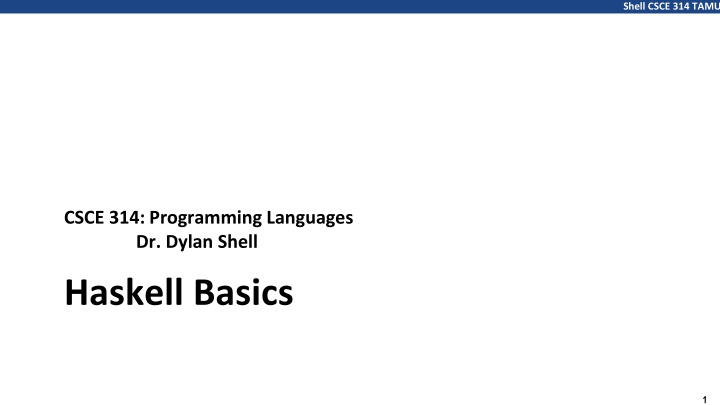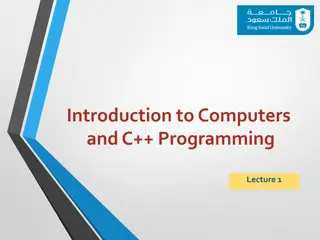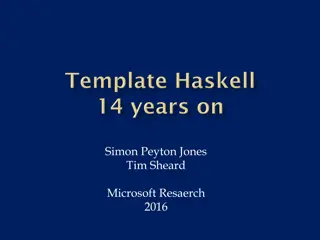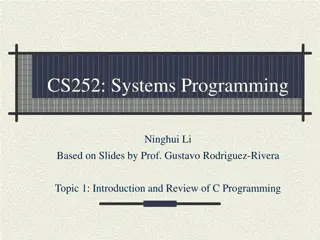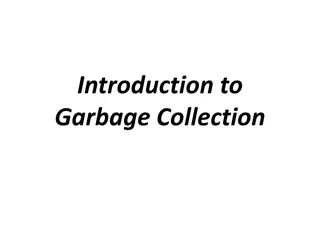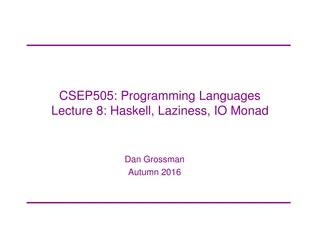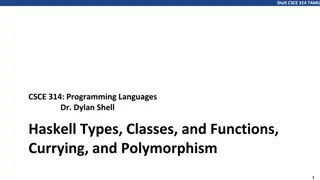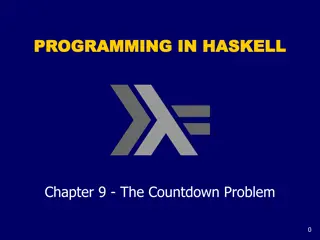Introduction to Haskell Programming Basics
This content provides an overview of Haskell programming language basics, including using GHC and GHCi from a shell window, historical background, functions, exercises, and handling Haskell scripts. Learn essential commands and tips to start coding in Haskell efficiently and understand the structure of Haskell scripts for effective programming.
Download Presentation

Please find below an Image/Link to download the presentation.
The content on the website is provided AS IS for your information and personal use only. It may not be sold, licensed, or shared on other websites without obtaining consent from the author.If you encounter any issues during the download, it is possible that the publisher has removed the file from their server.
You are allowed to download the files provided on this website for personal or commercial use, subject to the condition that they are used lawfully. All files are the property of their respective owners.
The content on the website is provided AS IS for your information and personal use only. It may not be sold, licensed, or shared on other websites without obtaining consent from the author.
E N D
Presentation Transcript
Shell CSCE 314 TAMU CSCE 314: Programming Languages Dr. Dylan Shell Haskell Basics 1
Shell CSCE 314 TAMU Contents 1. Jump into Haskell: Using ghc and ghci (more detail) 2. Historical Background of Haskell 3. Lazy, Pure, and Functional Language 4. Functions 5. Exercises 2
Shell CSCE 314 TAMU Demo some basics 3
Shell CSCE 314 TAMU Using GHC and GHCi From a shell window, the compiler is invoked as > ghc myfile.hs > ghci (or as > ghc --interactive) For multi-file programs, use --make option GHCi operates on an eval-print-loop: User types in a Haskell expression > sqrt (3^2 + 4^2) 5.0 > The interpreter evaluates it and prints out the result Waits for the next expression 4
Shell CSCE 314 TAMU Using GHC and GHCi From a shell window, the compiler is invoked as > ghc myfile.hs > ghci (or as > ghc --interactive) For multi-file programs, use --make option Important: Make your edit-compile-run cycle convenient! I m going to use vim Some people use Emacs and haskell-mode https://github.com/serras/emacs-haskell-tutorial/blob/master/tutorial.md 5
Shell CSCE 314 TAMU Using GHCi Useful basic GHCi commands: :? :load test :reload :main a1 a2 :! :edit name :edit :type expr :quit Help! Show all commands Open file test.hs or test.lhs Reload the previously loaded file Invoke main with command line args a1 a2 Execute a shell command Edit script name Edit current script Show type of expr Quit GHCi Commands can be abbreviated. E.g., :r is :reload At startup, the definitions of the Standard Prelude are loaded Hint: GHCi executes commands from $HOME/.ghci, then from ./.ghci at startup 6
Shell CSCE 314 TAMU Haskell Scripts A Haskell program consists of one or more scripts. A script is a text file comprising a sequence of definitions, where new functions are defined. By convention, Haskell scripts usually have a .hs suffix on their filename. This is useful for identification purposes. Loading new script causes new definitions to be in scope: Prelude> :l test.hs [1 of 1] Compiling Main ( test.hs, interpreted ) Ok, modules loaded: Main. *Main> 7
Shell CSCE 314 TAMU My First Script When developing a Haskell script, it is useful to keep two windows open, one running an editor for the script, and the other running GHCi: Start an editor, type in the following two function definitions, and save the script as test.hs: double x = x + x quadruple x = double (double x) In another window start up GHCi with the new script: % ghci test.hs Now both the standard library and the file test.hs are loaded: > quadruple 10 40 > take (double 2) [1,2,3,4,5,6] [1,2,3,4] 8
Shell CSCE 314 TAMU Historical Background 1930s: Alonzo Church develops the lambda calculus, a simple but powerful theory of functions. Proved that Peano arithmetic and first-order logic are undecidable. Sources: http://www.alpcentauri.info/church.jpg 9
Shell CSCE 314 TAMU Historical Background 1950s: John McCarthy develops Lisp, the first functional language, with some influences from the lambda calculus, but retaining variable assignments. (Organizes the Dartmouth conference, becomes one of the founders of the field of A.I.) Sources: http://engineering.stanford.edu/news/stanfords-john-mccarthy-seminal-figure-artificial-intelligence-dead-84 10
Shell CSCE 314 TAMU Historical Background 1960s: Peter Landin develops ISWIM, the first pure functional language, based strongly on the lambda calculus, with no assignments. (Also his off-side rule, which we see in Haskell, Python, ) Sources: http://www.theguardian.com/technology/2009/sep/22/peter-landin-obituary 11
Shell CSCE 314 TAMU Historical Background 1970s: John Backus develops FP, a functional language that emphasizes higher-order functions and reasoning about programs. Robin Milner and others develop ML, the first modern functional language, which introduced type inference and polymorphic types. Sources: http://download.101com.com/wa-mcv/cam/images/20070327ctnu2.jpg https://www.flickr.com/photos/rolandeva/3790820009 12
Shell CSCE 314 TAMU Historical Background 1970s- 1980s: David Turner develops a number of lazy functional languages, culminating in the Miranda system. Sources: http://www.codemesh.io/codemesh2013 13
Shell CSCE 314 TAMU Historical Background 1987: An international committee of researchers initiates the development of Haskell, a standard lazy pure functional language. 14
Shell CSCE 314 TAMU Historical Background 2003: The committee publishes the Haskell 98 report, defining a stable version of the language. 15
Shell CSCE 314 TAMU Historical Background Since 2003? Next round of standardization has begun: Haskell (Haskell prime) a continuous standardization process Status in 2017? A widely used and highly influential language for programming language research Reasonably widely used in open-source software Modest commercial use 16
Shell CSCE 314 TAMU Haskell is a Lazy Pure Functional Language 17
Shell CSCE 314 TAMU Haskell is a Lazy Pure Functional Language A functional language supports the functional programming style where the basic method of computation is application of functions to arguments. For example, in C, int s = 0; for (int i=1; i <= 100; ++i) s = s + i; the computation method is variable assignment. In Haskell, sum [1..100] the computation method is function application. 18
Shell CSCE 314 TAMU Haskell is a Lazy Pure Functional Language A pure functional language, as with mathematical functions, prohibits side effects (or at least they are confined): Immutable data: Instead of altering existing values, altered copies are created and the original is preserved, thus, there s no destructive assignment: a = 1; a = 2; -- illegal Referential transparency: Expressions yield the same value each time they are invoked; helps reasoning. Such expression can be replaced with its value without changing the behavior of a program, for example, y = f x and g = h y y then, replacing the definition of g with g = h (f x) (f x) will get the same result (value). 19
Shell CSCE 314 TAMU Haskell is a Lazy Pure Functional Language A lazy programming language only evaluates arguments when strictly necessary, thus, 1. avoiding unnecessary computation and 2. ensuring that programs terminate whenever possible. For example, given the definitions omit x = 0 keep_going x = keep_going (x+1) what is the result of the following expression? omit (keep_going 1) 20
Shell CSCE 314 TAMU Features of Functional Languages Higher-order functions are functions that take other functions as their arguments. E.g., > map reverse ["abc","def"] ["cba","fed ] Purity prohibits side effects (Expressions may result in some actions in addition to return values, such as changing state and I/O; these actions are called side effects.) Recursion the canonical way to iterate in functional languages 21
Shell CSCE 314 TAMU Other Characteristics of Haskell Statically typed Type inference Rich type system Succinct, expressive syntax yields short programs Indentation matters Capitalization of names matters 22
Shell CSCE 314 TAMU Demo some basics with lists 23
Shell CSCE 314 TAMU The Standard Prelude Haskell comes with a large number of standard library functions. In addition to the familiar numeric functions such as + and *, the library also provides many useful functions on lists. -- Select the first element of a list: > head [1,2,3,4,5] 1 -- Remove the first element from a list: > tail [1,2,3,4,5] [2,3,4,5] 24
Shell CSCE 314 TAMU -- Select the nth element of a list: > [1,2,3,4,5] !! 2 3 -- Select the first n elements of a list: > take 3 [1,2,3,4,5] [1,2,3] -- Remove the first n elements from a list: > drop 3 [1,2,3,4,5] [4,5] -- Append two lists: > [1,2,3] ++ [4,5] [1,2,3,4,5] 25
Shell CSCE 314 TAMU -- Reverse a list: > reverse [1,2,3,4,5] [5,4,3,2,1] -- Calculate the length of a list: > length [1,2,3,4,5] 5 -- Calculate the sum of a list of numbers: > sum [1,2,3,4,5] 15 -- Calculate the product of a list of numbers: > product [1,2,3,4,5] 120 26
Shell CSCE 314 TAMU Demo some basics with functions 27
Shell CSCE 314 TAMU Functions (1) Function and parameter names must start with a lower case letter, e.g., myFun1, arg_x, personName, etc. By convention, list arguments usually have an s suffix on their name, e.g., xs, ns, nss Functions are defined as equations: square x = x * x add x y = x + y Once defined, apply the function to arguments: > square 7 > add 2 3 49 5 In C, these calls would be square(7); and add(2,3); Parentheses are often needed in Haskell too > add (square 2) (add 2 3) 9 28
Shell CSCE 314 TAMU Functions (2) Function application has the highest precedence square 2 + 3 means (square 2) + 3 not square (2+3) Function call associates to the left and is by pattern matching (first one to match is used) Function application operator $ has the lowest precedence and is used to rid of parentheses. sum ([1..5] ++ [6..10]) -> sum $ [1..5] ++ [6..10] Combinations of most symbols are allowed as function x #@$%^&*-+@#$% y = "What on earth? Another (more reasonable) example: x +/- y = (x+y, x-y) > 10 +/- 1 (11,9) 29
Shell CSCE 314 TAMU Function Application In mathematics, function application is denoted using parentheses, and multiplication is often denoted using juxtaposition or space. Apply the function f to a and b, and add the result to the product of c and d f(a,b) + c d In Haskell, function application is denoted using space, and multiplication is denoted using *. As previously, but in Haskell syntax f a b + c*d 30
Shell CSCE 314 TAMU Examples Mathematics Haskell f(x) f x f(x,y) f x y f(g(x)) f (g x) f(x,g(y)) f x (g y) f(x)g(y) f x * g y 31
Shell CSCE 314 TAMU Evaluating Functions (1) Think of evaluating functions as substitution and reduction add x y = x + y; square x = x * x add (square 2) (add 2 3) 32
Shell CSCE 314 TAMU add x y = x + y; square x = x * x add (square 2) (add 2 3) apply square: add (2 * 2) (add 2 3) apply : add 4 (add 2 3) apply inner add : add 4 (2 + 3) apply + : add 4 5 apply add 4+5 apply + 9 33
Shell CSCE 314 TAMU Evaluating Functions (2) There are many possible orders to evaluate a function head (1:(reverse [2,3,4,5])) head (1:(reverse [2,3,4,5])) apply reverse apply head ... many steps omitted here 1 head (1 : [5,4,3,2]) apply head 1 Was the same output a fluke? 34
Shell CSCE 314 TAMU Evaluating Functions (2) There are many possible orders to evaluate a function In a pure functional language, evaluation order does not affect the value of the computation It can, however, affect the amount of computation and whether the computation terminates or not (or fails with a run-time error) Haskell evaluates a function s argument lazily Call-by-need - only apply a function if its value is needed, and memoize what s already been evaluated 35
Shell CSCE 314 TAMU Leaving GHCi open, return to the editor, add the following definitions, and resave: factorial n = product [1..n] average ns = sum ns `div` length ns Note: div is enclosed in back quotes, not forward ones x `f` y is syntactic sugar for f x y Any function with two (or more args) can be used as an infix operator (enclosed in back quotes) Any infix operator can be used as a function (enclosed in parentheses), e.g., (+) 10 20 288> :r Reading file "test.hs" GHCi does not automatically detect that the script has been changed, so a reload command must be executed before the new definitions can be used: > factorial 10 3600 > average [1,2,3,4,5] 3 36
Shell CSCE 314 TAMU The Layout Rule Layout of a script determines the structure of definitions Commonly use layouts instead of braces and semicolons (which are still allowed and can be mixed with layout) Each definition must begin in precisely the same column: a = 10 b = 20 c = 30 a = 10 b = 20 c = 30 a = 10 b = 20 c = 30 a = b + c a = b + c where where {b = 1; c = 2} means b = 1 c = 2 implicit grouping by layout explicit grouping by braces and semicolons d = a * 2 d = a * 2 37
Shell CSCE 314 TAMU Exercises (1) Try out the code in the previous slides using GHCi, if you ve not already. (2) Fix the syntax errors in the program below, and test your solution using GHCi. N = a div length xs where a = 10 xs = [1,2,3,4,5] 38
Shell CSCE 314 TAMU Exercises (1) Try out the code in the previous slides using GHCi, if you ve not already. (2) Fix the syntax errors in the program below, and test your solution using GHCi. N = a div length xs where a = 10 xs = [1,2,3,4,5] n = a `div` length xs where a = 10 xs = [1,2,3,4,5] 39
Shell CSCE 314 TAMU Show how the library function last that selects the last element of a list can be defined using the functions introduced in this lecture. (3) last xs = ... Can you think of another possible definition? (4) last xs = ... (5) Similarly, show how the library function init that removes the last element from a list can be defined in two different ways. init xs = ... init xs = ... 40
Shell CSCE 314 TAMU A Taste of Haskell f [] = [] f (x:xs) = f ys ++ [x] ++ f zs where ys = [a | a xs, a <= x] zs = [b | b xs, b > x] ? 41
